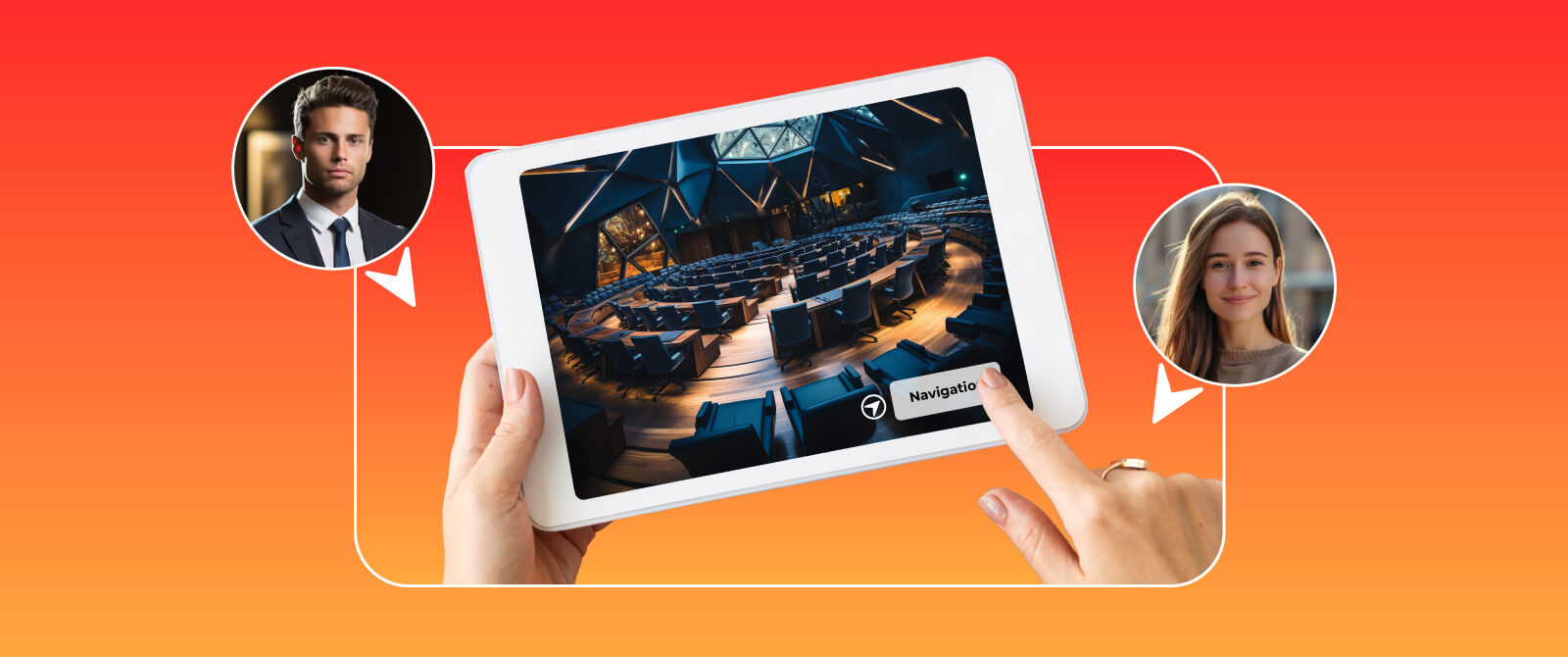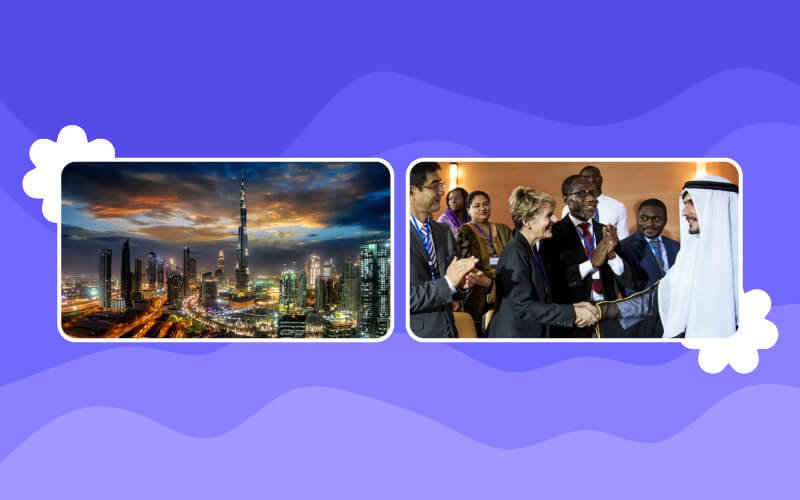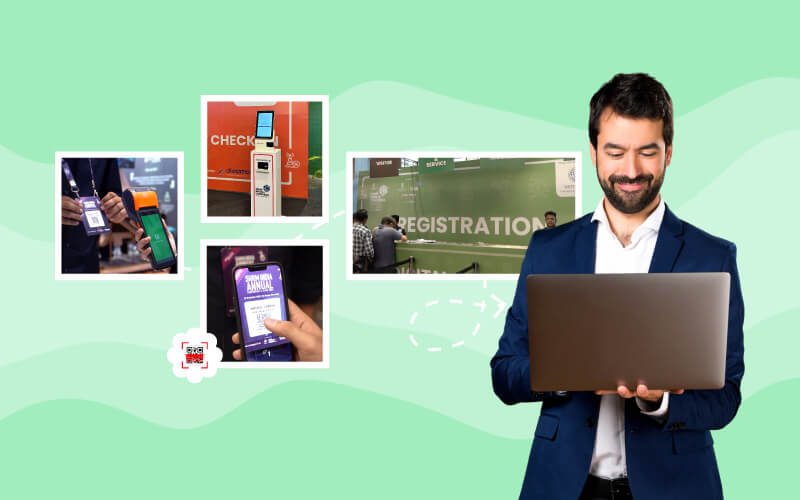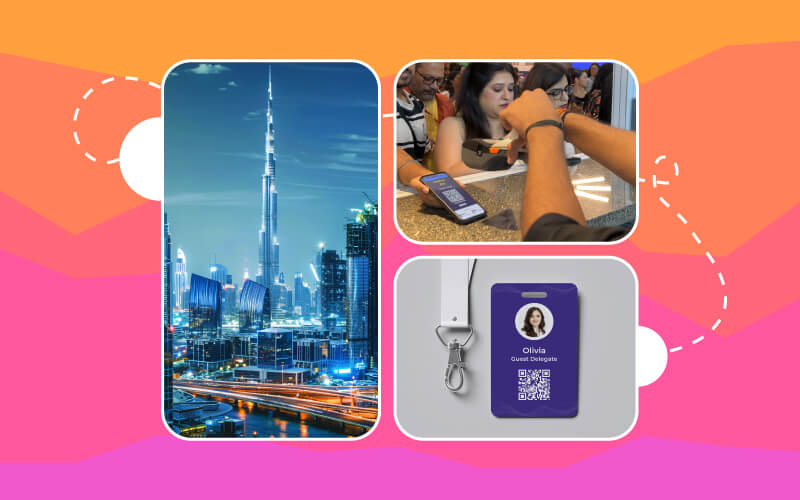Do you still need help to rely on flowcharts or 2D diagrams to visualize and plan your events? As technology gets ahead with every passing day, event professionals might need a more immersive experience or innovative ways to bring their vision into reality. That’s where 3D event diagramming comes in – creating a place in an increasingly complex and competitive event landscape.
In this growing event industry, a study found unprecedented growth in the global events market which is about to reach $1.76 trillion by 2029. In such a scenario, 3D event layout diagramming has become a game-changing tool that transformed how events are planned, designed, & executed. Moreover, with events getting more sophisticated and elaborated, the demand for precise planning and visualization has risen. Therefore, event diagramming is not just a necessity, but a must-have tool for event professionals who want to deliver exceptional experiences.
In this blog, we are going to explore the benefits and applications of 3D event diagramming, 3D event floor plans, and much more including its transforming the way event professionals work.
What is 3D Event Diagramming?
Have you ever attended an event that just flowed perfectly? Everything from conference session rooms and buffet tables to the event stage was perfectly placed to allow attendees and staff to move around easily. In addition to all such arrangements, the execution also runs smoothly and on schedule. That’s the magic of great event technology – 3D event diagramming. Let’s understand this by imagining this as a digital replica of your event venue, with 3D event floor plans and layout.

In simple terms, “3D event layout diagramming is the process of designing detailed, three-dimensional visual representations of an event’s physical venue with different layouts to plan and design events which gives ultimate satisfaction”.
Moreover, 3D event diagramming requires specialized platforms/software to generate innovative and immersive virtual models that help event professionals visualize the design of events and manage event logistics. Furthermore, event diagramming is used to:
- Create accurate floor plans and seating charts
- Design and visualize event layouts, including staging, lighting, and sound
- Plan and manage event logistics, such as crowd flow and traffic
- Visualize and coordinate event decor and branding
- Communicate event designs and 3D event floor plans to stakeholders and vendors
- Enhance event safety and security planning
- Streamline event setup and teardown
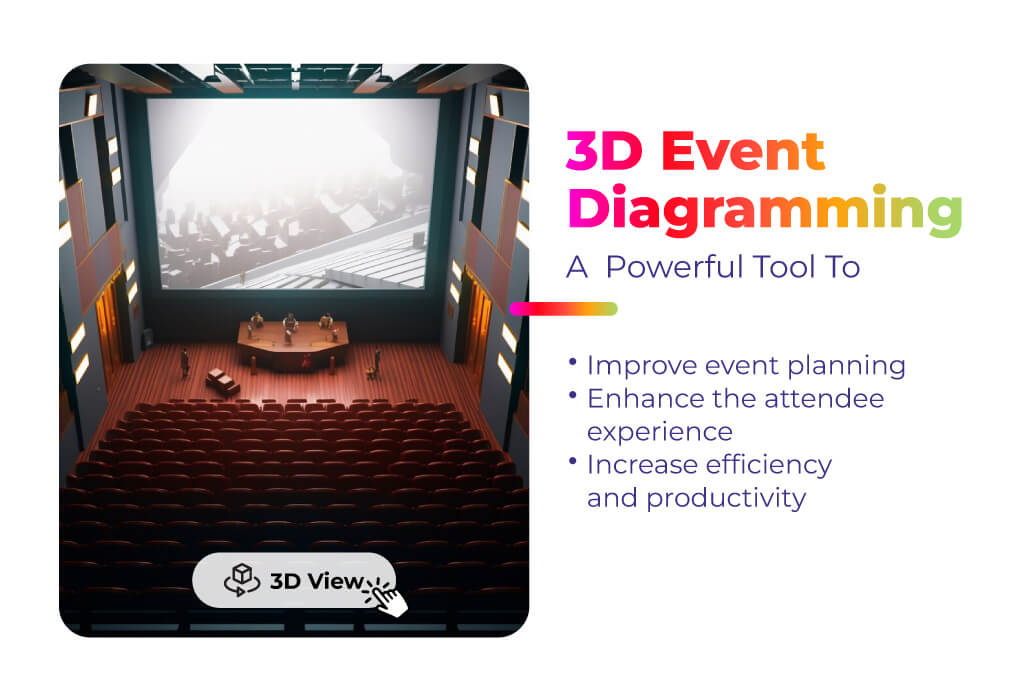
How Event Diagramming Works?
3D event diagrams take the traditional 2D-floor event plan to the next level by creating a virtual, three-dimensional representation of an event space. This event technology offers a more creative and realistic preview of the event layout. Before knowing how it works, let’s explore its components:
Core Components of 3D Event Floor Plans
- 3D Modeling: The event space is digitally reconstructed using precise measurements and architectural details to create a 3D model for the event.
- Object Library: A vast collection of 3D objects representing various virtual event elements (tables, chairs, stages, booths, etc.) is available for placement within the model.
- Customization: Event organizers can modify objects’ appearance, size, and texture to match specific event requirements.
- Spatial Awareness: The software/platform used in diagramming provides tools to accurately measure distances, heights, and angles within the 3D environment.
- Real-Time Rendering: The software used for diagramming generates a real-time 3D visualization of the event layout as changes are made.
Let’s Know How Event Diagramming Functions
No doubt it’s a crucial process in event planning and management Here’s a step-by-step overview of how 3D diagramming works and its implementation;
1. Data Collection
The very first step of event diagramming begins with event professionals collecting minor to major detailed information about the event space. This includes venue dimensions, layout, infrastructure, and any specific requirements or limitations. Accurate data collection is essential for creating a realistic and usable event diagramming procedure.
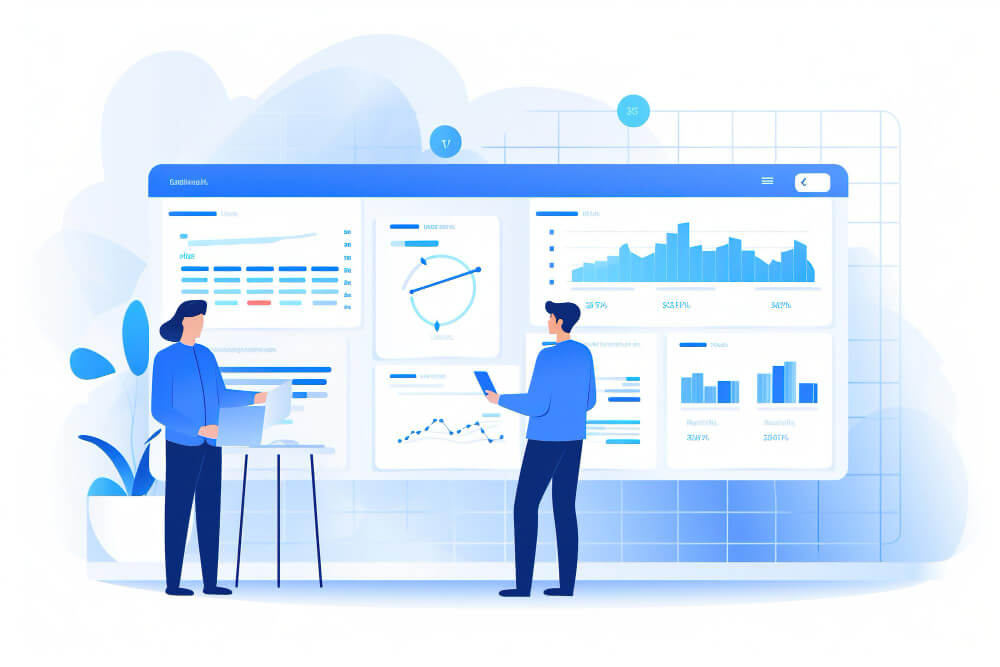
2. Software Selection
The next step involves choosing specialized 3D event diagramming software, such as Social Tables, or others. These tools are designed to handle the complexities of event spaces and offer features that facilitate accurate modeling and event planning.
3. 3D Modeling
With the chosen software for event diagramming, event organizers can create a 3D model of the event space. This model includes all virtual structural elements like walls, floors, interiors, and permanent fixtures. The 3D model serves as the foundation for all future event planning and designing of activities.
4. Event Design
With the 3D model in place, professionals design the event floor plan or layout by adding and arranging elements such as rooms, displays, seating arrangements, stages, tables, chairs, lighting, and decor. However, seating arrangements may depend on event type. For instance, theater-style seating for a conference or banquet-style seating for a gala, This step ensures that the space is utilized efficiently and aligns with the event’s vision and goals.
Read More: How to Plan Event Management for Conferences?
5. Collaboration
After finalizing the event design, the 3D event diagram is shared with stakeholders, vendors, and team members to gather feedback and for modification, if anything is not found well. However, this collaborative process ensures that all parties are aligned and any potential issues are addressed early, leading to a more cohesive onsite event solution.
6. Visualization
The interactive event 3D diagramming allows event professionals to visualize the event from multiple angles. Here event organizers have the opportunity to identify potential issues, such as obstructions (columns, equipment, or large decor items), technical and electrical layouts, blocked emergency exits, narrow pathways, or inadequate spacing between elements and overcrowded areas (entry points, event registration desks, or popular booths). By having a look at these, organizers can make adjustments before the event for a smoother execution.
7. Logistics Planning
The 3D diagramming of the event further aids in event planning logistics such as crowd flow, emergency exits, adhering to capacity limits, signage, wayfinding, coordinating with delivery, setup, traffic patterns transportation & parking, attendee services including essential amenities, staffing and volunteer management and emergency routes. By mapping these out in advance, event planners can enhance safety and efficiency while ensuring that attendees have full safety throughout the space.
8. Event Execution
On the day of the event, the finalized 3D event pictures guide the setup. It ensures the accurate placement of elements and proper use of space that allows the setup team to work more effectively and adhere to the planned design.
9. Event Evaluation
The working of event technology doesn’t end with the event. Post-event, the 3D diagramming helps identify the event’s success. Event professionals can evaluate what worked well and what didn’t, using the insights to make improvements for future events. For instance, 3D event diagramming helps attendees efficiently reach booths and register themselves. Event organizers can track and analyze attendee movements, optimizing booth placements and improving the overall event experience.
By leveraging 3D event layout diagramming, you can streamline planning, enhance collaboration, and deliver exceptional events that exceed attendees’ expectations.
6 Benefits of Event Diagramming: Improve Event Coordination
Undoubtedly, event diagram layout plays an essential role in event planning and management. Here are the top benefits of 3D event diagrams;
1. Improved Visualization
One of the topmost benefits of event diagramming is better visualization. With this, organizers can create detailed, interactive, and absorbing visual representations of their desired event. This not only aids in their capabilities to visualize the event floor plans but also look after potential issues that may arise. Also, visualization helps in making informed decisions which further saves a fortune.
2. Enhanced Teamwork
3D event layouts offer shared understanding as they facilitate collaboration among event stakeholders, vendors, and team members. When everyone is on the same page and knows about the event’s entire plan, it gets easier to make on-spot decisions or make any changes to the event’s floor plan. As a result, it ensures that everyone understands the plans, schedule, and layouts effectively

3. Improved Efficiency
To streamline event planning, event diagramming plays an essential role by reducing the need for physical visits to the event’s venue, measurements, and manual drawings. In addition, it also assists with identifying the event’s logistical issue beforehand, as a result, it saves time and resources.
4. Cost Savings
By identifying potential issues and optimizing the 3D event floor plans, diagramming can help reduce costs associated with venue rentals, equipment, and labor. Let’s have a look at how it saves costs by:
- Optimized space utilization
- Reduced setup time
- Effortless event registration management
- Minimized errors and adjustments
- Improved vendor coordination
- Efficient resource allocation
5. Enhanced Attendee Experience
By creating a more immersive and engaging event environment, 3D event diagramming can lead to increased attendee engagement and overall event success. It benefits attendees by visually giving access to the event layout in 3D. So that they can easily understand the flow of the event. Additionally, the integration of clear signage and wayfinding elements also enhances the experience. Moreover, attendees can depict the event’s ambience, and decor, while optimizing their time in identifying preferred sessions and exhibit booths.
6. Improved Safety and Security
3D event layouts help event professionals identify potential safety and security risks. This enables them to develop strategies to mitigate concerns and ensure safer event risk management. These include data security from cyber threats, regular system maintenance, multifactor authentication etc.
How to Integrate 3D Event Diagramming for Enhanced Events?
Time to explore the most interesting part, the integration of event technology in a 3D event floor plan for an enhanced experience.
Mobile event apps play a crucial role in the seamless integration of 3D event diagramming. It makes the event experience more immersive and user-friendly by integrating with 3D diagramming and utilizing built-in features like Wayfinder and digital signage. These mobile apps, specifically designed for events such as conferences and AGMs, enable attendees to navigate the venue effortlessly.
However, the 3D Wayfinder functionality within these apps provides an intuitive and interactive map that guides attendees to various locations within the event. Additionally, digital signage integration ensures that 3D event diagrams are displayed throughout the venue. This offers engaging and interactive event information at attendees’ fingertips.
Read more:- How Conference Mobile Apps Drive Benefits for Organizers & Attendees?
These integrations enhance the event experience, provide valuable insights, and streamline event registration management. By combining 3D event diagramming with event technology. Event professionals can create immersive, engaging, and memorable events that exceed attendees’ expectations.
Conclusion
By the end of the blog post, we have explored the what, why, and how of 3D event diagramming along with its integration with modern event technologies. From enhanced visualization and collaboration to improved safety and attendee experience, the benefits of 3D event floor plans are undeniable. As the event industry continues to evolve, the importance of 3D diagramming will only grow. Event professionals who adopt this technology will be at the forefront of innovation, setting new standards for event excellence. However, many tools are widely used for diagramming events, such as Social Tables, All Seated, Floor Planner, and CAD-based software like AutoCAD and SketchUp. A wide range of events can be planned using these tools, from weddings to corporate meetings to trade shows and conferences. We hope this comprehensive guide has inspired you to harness the power of 3D event floor diagramming for your next event.



